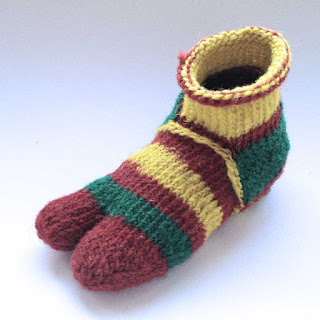My private museum - Part 2: Knitted socks and stockings
Unlike the tablet-woven bands, which were from the start intended to be displayed, my collection of replicas of knitted objects started as a serie of knitting experiments for reverse engineering or estimating how thin needles were needed for this or that gauge. Only later I added the objects knitted after patterns of other authors, to show the variability of knitting in the past.
In chronological order:
Child's woolen sock from Egypt (nowadays in the museum in Manchester), 2nd century CE. Nalbound, not knitted! A similar (and more famous) sock is in British museum, but I did not have the yarn in right colours for that one. :-)
Child's cotton sock from Egypt (nowadays in the Textile Museum in Washington DC), 12th-15th century CE. This replica is a result of many hours spent over the detailed photo, combined with the pattern found on internet - and yet, halfway through my knitting I realized that the jog in my sock is on the opposite side, which means the original sock was knitted in a different way.
Child's woollen stocking from London, 16th century. Based on the pattern published in the book Tudor Child. My first knitting for which I used my own hand-spun yarn.
Pair of child's silk stockings, dated 1650-1750, nowadays in MFA, Boston. I am quite sure with the accuracy of my pattern based on the detailed photo, but due to too thick yarn (it is hard enough to get any silk yarn, regardless its weight) my replica is 20% larger than the original. Two years after knitting was completed, the embroidery is not finished yet.
Stockings inspired by the burial stockings of Margaretha Franziska Lobkowicz (+1617) for the article and the pattern in PieceWork. With regards to modern knitters I used yarn of fingering weigth to get a gauge 42 loops* and 55 courses per 10 cm, instead of silk and metallic yarn and the original gauge 70 loops and 90 courses per 10 cm. However, later I knitted a small silk sample to show the fineness of the original stockings.
A hand-knitted stocking after the fashion of the 16th/17th century and a frame-knitted stocking from the 18th century to show the development of the style and technique. (I hope to get better photo soon.)
--------------------------------
* loops = stitches, courses = rows; I am following the terminology proposed by Jane Malcolm-Davies et al. in the article Unravelling the confusions: Defining concepts to record archaelogical and historical evidence for knitting, Archaelogical Textile Review 60, pp. 10-24 (2018).
In chronological order:
Child's woolen sock from Egypt (nowadays in the museum in Manchester), 2nd century CE. Nalbound, not knitted! A similar (and more famous) sock is in British museum, but I did not have the yarn in right colours for that one. :-)
Child's woollen stocking from London, 16th century. Based on the pattern published in the book Tudor Child. My first knitting for which I used my own hand-spun yarn.
Pair of child's silk stockings, dated 1650-1750, nowadays in MFA, Boston. I am quite sure with the accuracy of my pattern based on the detailed photo, but due to too thick yarn (it is hard enough to get any silk yarn, regardless its weight) my replica is 20% larger than the original. Two years after knitting was completed, the embroidery is not finished yet.
Stockings inspired by the burial stockings of Margaretha Franziska Lobkowicz (+1617) for the article and the pattern in PieceWork. With regards to modern knitters I used yarn of fingering weigth to get a gauge 42 loops* and 55 courses per 10 cm, instead of silk and metallic yarn and the original gauge 70 loops and 90 courses per 10 cm. However, later I knitted a small silk sample to show the fineness of the original stockings.
A hand-knitted stocking after the fashion of the 16th/17th century and a frame-knitted stocking from the 18th century to show the development of the style and technique. (I hope to get better photo soon.)
--------------------------------
* loops = stitches, courses = rows; I am following the terminology proposed by Jane Malcolm-Davies et al. in the article Unravelling the confusions: Defining concepts to record archaelogical and historical evidence for knitting, Archaelogical Textile Review 60, pp. 10-24 (2018).





